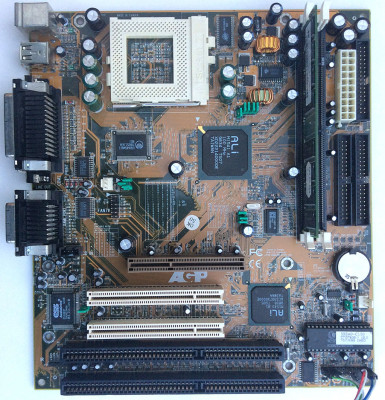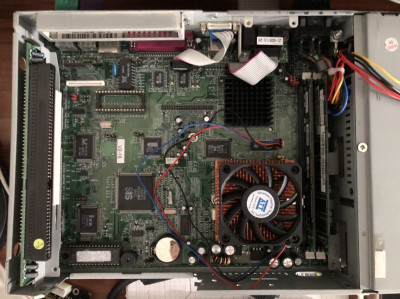The Asus P5A-B is just about the same size (and layout) as the GA-5AA, same weird under-socket mounting screw, too. (and benefit of the socket not blocking any of the expansion slots).
But what about this weird thing?
https://i.ebayimg.com/images/g/z7IAAOSwUVFcWSGX/s-l1600.jpg
(I can post some better pics of my own, later)
It looks like a mini itx board, and one could even assume it's actually some sort of Media GX/Geode implementation (using a generic Socket 7 ZIF assembly), but the additional I/O chips don't match that (normal Socket 7/370 late 90s era sound and network I/O chips) and beneath that serial number sticker is an XCel2000 logo on the heatsink ... which normally got used by PCChips S370/slot-1 boards using SiS chipsets, but going further and peeling off that heatsink shows it's an SiS5598 chip (which is easy to guess given how few 1-chip S7 chipsets were made). On top of that is has what looks like a PCI-e aux 6-pin power connector as its sole power source, and the key configuration is the same but I'm not sure if the pinout is compatible. (same goes for dedicated 20 pin ATX to 6-pin adapters)
or for that matter, modern 24-pin ATX to 6 pin adapters
but that seems to be a proprietary modern HP sort of deal (might be a Dell thing too, since their older proprietary 20+6 pin proprietary ATX system PSUs were used by both Dell and HP).
There's no obvious brand-name manufacturer logo/name printed on the board, so I assume it's not really a Dell/HP/Compaq deal.
It might be some oddball thin client board or something in that same vein, but doesn't match the typical client form factor of that era either, but the integrated ethernet adapter seems to maybe indicate that sort of role. (it's got onboard video and sound outputs too. Plus what looks like the female end of an IDE port, implying either using a female to male IDE cable or direct plug-in mount of some compact HDD or SSD module (I don't think it's a PCMCIA header ... and it's 40 pins like IDE). Short little female to male IDE cables seem to be common enough, presumably normally used as extender cables, but would be about right for something like this.
I haven't been able to find any documentation of this board so far and don't really want to try powering it on without knowing what that power connector pinout is. It'd make a neat, super compact portable/small footprint DOS gaming rig though ... the sound chip seems to be a decent SB-compatible one too, but the lack of game port is a limiting factor. (keyboard+mouse games would work fine, and those PS/2 key-mapping gamepads might work well enough for some flight/space sim games with keyboard support ... not sure if there's any mouse-emulator joysticks out there, but that'd be neat ... come to think of it, given the much lower CPU overhead for reading PS/2 or serial mouse ports vs analog joystick polling, I wonder why that wasn't actually a big thing back in the 286~486 era ... and the N64 gamepad uses a ball-mouse style optical mechanism for its X/Y axis)
There's also USB, so plenty of options for windows compatible games, but that's also limited to games supporting software rendering given the chipset.
Also, I assume the "300/75/2.9V" sticker on the sound port block refers to the CPU that was intended to be installed ... namely a Cyrix/IBM 6x86MX/MII PR300 at 3x75 MHz. (also a somewhat warm running CPU for what I assume was originally a very small box system)
Or given the PCChips related heatsink and the PCChips/Amptron typical bronze colored PCB, maybe it was an OEM board for some 1998 vintage low-end OEM desktop PC ... it could easily fit into normal ATX/mATX mini-towers. (maybe similar to some of the systems the tiny Baby AT XCel2000 slot 1 and S370 boards were intended for ... assuming they were used by OEMs at all)
I almost picked up one of those dual-socket/slot boards that was at a more reasonable price a month or so ago, but ended up passing on it. (it came with the header cables which is nice and also might have made a decent portable project box sort of thing, but ... it still wasn't super cheap and those board have a very mixed reputation, or typical PCChips reputation and worse than the mid/late gen Socket 7 PCChips board reputation ... though I do have a dead Amptron 8600 that came free/as-is with an IBM 6x86L-200 from like ... 9 years ago I think and a 286-20 board that looks like it might be PC-Chips related, at least an oddity being DIP socketed and not SIMM equipped)
at a glance it does look a lot like some of those tin client/embedded systems MediaGX/Geode boards, like this thing:
https://i.ebayimg.com/images/g/WuEAAOSwtAlbwMDt/s-l1600.jpg
But the onboard chipset logos and peripheral ports are totally different (and many of those thin client and embedded boards lack video output and conventional I/O ports).
Also erroneously listed as Socket 7 ... due to the physical socket molding (as with many socketed Geode products, apparently).
It's actually for an HP print server appliance server box:
Though the use of 4-pin IDE style MOLEX power connectors are certainly less mysterious than that 6-pin thing on my board. (re-use of an old AT style 6-pin connector would also be less mysterious given the period in question and use of that as an aux power connector by OEMs)
That or there's a whole other short-lived form factor that actually tried to standardize on that power connector set-up.
Anyway, the Board measures just about 175x180 mm, so just slightly larger than mini ITX spec. (which it presumably predates given the 1998 BIOS sticker)
Apparently no board-level cache either (unless the chipset itself has any), but a 6x86MX wouldn't do too bad with the 64k unified L1 if it was originally intended as a low-end office/home desktop sort of like those lightweight, almost-empty-feeling (and looking) HP budget-rage PCs with AMD Jaguar or Puma APUs in them from a few years back. Though a K6-2 would be way better suited to any multimedia stuff from 98/99. (and potentially for my micro-gaming-box idea, though an overclocked P55C might be better even with the cache restriction ... especially if a Tilamook CPU will work in it, otherwise an undervolted P55C at 3x75 MHz might be more realistic ... depending what voltage selection the board even has)
OTOH some of Origin Systems game engines seem to really favor Cyrix 6x86/M2 series chips (WCIII/IV in particular, probably being more 386/486 optimized code without any use of FPU or pentium-optimized scheduling) ... and there's always a K6-III/2+/III+ possibility. (though I'd kind of like the novelty of setting up a box with an MII running stable at 2.2V and 3.5x75 MHz ... especially if I brought the thing to some retro PC meet-up or something ...).
A K6-2/3/+ would also run Unreal's software renderer best due to the MMX performance, so there's that gimmick, too. (for actual gaming that's more just a curiosity/novelty thing given there's so many other ways to play Unreal)
And on a totally random note, having that tiny board on hand is really convenient for assisting in straightening/truing (slightly) bent pins on Socket 7 CPUs. (seems to have looser tolerances than my P5A-B, too, more able to accept just-barely-too-bent pins and help sort them out) I was already using that dead Amptron board for that before, but the little board is handy for that until I can do something better with it.



